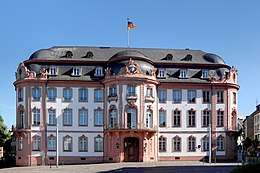Avant-corps
An avant-corps (Italian: avancorpo or risalto, plural risalti, German: Risalit, Polish: ryzalit), a French term literally meaning "fore-body", is a part of a building, such as a porch or pavilion, that juts out from the corps de logis, often taller than other parts of the building.[1][2] It is common in façades in French Baroque architecture.

The garden façade of the Château de Maisons-Laffitte with three avant-corps, an arrangement typical of French Baroque châteaux

The Osteiner Hof in Mainz with three avant-corps
Particularly in German architecture, a corner Risalit is where two wings meet at right-angles. Baroque three-winged constructions often incorporate a median Risalit in a main hall or a stairwell, such as in Weißenstein Palace and the Roßleben Convent School.
Sources
Much of the text of this article comes from the equivalent German-language Wikipedia article retrieved on 18 March 2006.
- Gérard Fontaine, Charles Garnier's Opéra (Paris, 2000), p. 88.
- Curl, James Stevens (2006). Oxford Dictionary of Architecture and Landscape Architecture, 2nd ed., OUP, Oxford and New York, p. 52. ISBN 978-0-19-860678-9.
This article is issued from Wikipedia. The text is licensed under Creative Commons - Attribution - Sharealike. Additional terms may apply for the media files.